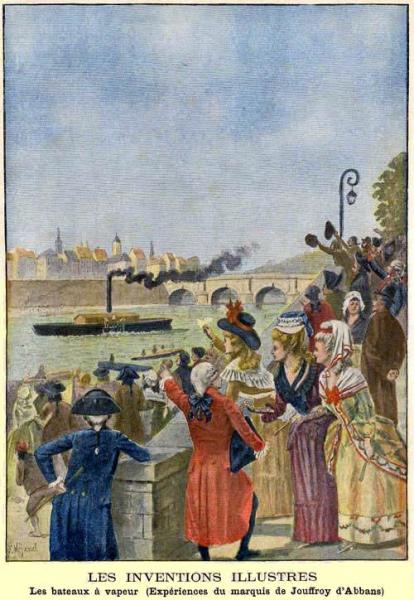The First Steamboat
Today, let's go looking for the first steamboat. The University of Houston's College of Engineering presents this series about the machines that make our civilization run, and the people whose ingenuity created them.
We tell our schoolchildren that Robert Fulton invented the first steamboat. What Fulton did do was locate an efficient new Watt engine in a warehouse. And in 1807 he installed it in a well-designed boat. We had a huge network of inland rivers we badly needed to navigate. Fulton enjoyed immediate commercial success.
He had access to a lot of new technology by 1807, and he put his boat together with an ease that would've been impossible just a few years before. His patent makes no pretense about inventing the steamboat. It acknowledges 30 years of early steamboat development.
 The story of one of those boats began in France. Two French artillery officers passed time in camp talking about how they might use steam to power boats. One officer, the Count d'Auxiron, left the army in 1770 to work full time on a boat. By 1772 he'd talked the French government into promising they'd give the first successful builder exclusive license to run the boat for fifteen years.
The story of one of those boats began in France. Two French artillery officers passed time in camp talking about how they might use steam to power boats. One officer, the Count d'Auxiron, left the army in 1770 to work full time on a boat. By 1772 he'd talked the French government into promising they'd give the first successful builder exclusive license to run the boat for fifteen years.
D'Auxiron installed a huge old Newcomen steam engine in a boat. The engine was so heavy that the boat sank. After three years of lawsuits, d'Auxiron died of apoplexy.
That would've ended it, but, while d'Auxiron was at work, another young aristocrat, the Marquis de Jouffroy, got involved in a duel. He landed in a military prison on the isle of Ste Marguerite. That's the same prison where the famous Man in the Iron Mask was held. During years of enforced contemplation he watched the boats below, and he thought about d'Auxiron.
When he got out in 1775, Jouffroy went to d'Auxiron and his supporters. He decided they were on the wrong track, and he left Paris for Lyon. There he built his own Newcomen-style engine and, in 1783, made a trial run with a 150-foot boat on the Saone river.
 For fifteen minutes, the boat chuffed past cheering crowds. Then it started breaking up under the pounding of the engine. Jouffroy managed to ease the boat to shore before anyone spotted the failure. He bowed to the cheering crowd. Then he sent affidavits to Paris, testifying to his success. After a long debate, the French Academy of Sciences decided the town of Lyon never could've succeeded where Paris had failed. They denied him a license.
For fifteen minutes, the boat chuffed past cheering crowds. Then it started breaking up under the pounding of the engine. Jouffroy managed to ease the boat to shore before anyone spotted the failure. He bowed to the cheering crowd. Then he sent affidavits to Paris, testifying to his success. After a long debate, the French Academy of Sciences decided the town of Lyon never could've succeeded where Paris had failed. They denied him a license.
Finally, the French Revolution drove Jouffroy out of France. He died poor and embittered. Still, he hadn't failed. For, after Jouffroy, Fulton could only be an aftermath. Fulton is really just America's thin claim to an invention that'd been proven feasible in Europe -- long, long before.
I'm John Lienhard, at the University of Houston, where we're interested in the way inventive minds work.
(Theme music)
Flexner, J.T., Steamboats Come True. Boston: Little Brown and Company, 1978.
L'expérience de Jouffroy d'Abbans en 1783 et la navigation à vapeur dans la région lyonnaise. Musé Historique de Lyon, Hotel Gadagne, 1983. (This is a catalog of Jouffroy materials from the Lyon Historical Museum)
Mollat, M., Les Origines de la Navigation a Vapeur. Paris: Presses Universitaires de France, 1970.
This episode is a revised version of Episode 6. My thanks to Philippe Vandermarlier for providing the Lyon Museum catalog. And my thanks to Jouffroy's relative, Christophe Zeilas, for providing me both with additional counsel and the two images above.

An artist's impression of Jouffroy's accomplishment